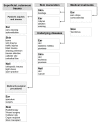Aspergillus Genus and Its Various Human Superficial and Cutaneous Features
- PMID: 34071092
- PMCID: PMC8224566
- DOI: 10.3390/pathogens10060643
Aspergillus Genus and Its Various Human Superficial and Cutaneous Features
Abstract
Superficial and cutaneous aspergillosis is a rare fungal disease that is restricted to the outer layers of the skin, nails, and the outer auditory canal, infrequently invading the deeper tissue and viscera, particularly in immunocompromised patients. These mycoses are acquired through two main routes: direct traumatic inoculation or inhalation of airborne fungal spores into paranasal sinuses and lungs. Lesions are classified into three categories: otomycosis, onychomycosis, and cutaneous aspergillosis. Superficial and cutaneous aspergillosis occurs less frequently and therefore remains poorly characterized; it usually involves sites of superficial trauma-namely, at or near intravenous entry catheter site, at the point of traumatic inoculation (orthopaedic inoculation, ear-self-cleaning, schizophrenic ear self-injuries), at surgery incision, and at the site of contact with occlusive dressings, especially in burn patients. Onychomycosis and otomycosis are more seen in immunocompetent patients, while cutaneous aspergillosis is widely described among the immunocompromised individuals. This paper is a review of related literature.
Keywords: Aspergillus; burns; cutaneous; onychomycosis; otomycosis; trauma.
Conflict of interest statement
The authors declare no conflict of interest.
Figures



Similar articles
-
Spectrum of Mycoses.In: Baron S, editor. Medical Microbiology. 4th edition. Galveston (TX): University of Texas Medical Branch at Galveston; 1996. Chapter 75. In: Baron S, editor. Medical Microbiology. 4th edition. Galveston (TX): University of Texas Medical Branch at Galveston; 1996. Chapter 75. PMID: 21413276 Free Books & Documents. Review.
-
Primary Cutaneous Aspergillosis Due to Aspergillus fumigatus in an Immunocompetent Patient with Diabetes Mellitus After Tattooing: A Case Report and Review of Literature.Infect Drug Resist. 2023 Feb 5;16:791-797. doi: 10.2147/IDR.S398858. eCollection 2023. Infect Drug Resist. 2023. PMID: 36779045 Free PMC article.
-
Primary cutaneous Aspergillus fumigatus infection in immunocompetent host.BMJ Case Rep. 2020 Feb 13;13(2):e233020. doi: 10.1136/bcr-2019-233020. BMJ Case Rep. 2020. PMID: 32060111 Free PMC article.
-
Onychomycosis Associated with Superficial Skin Infection Due to Aspergillus sydowii in an Immunocompromised Patient.Mycopathologia. 2019 Oct;184(5):683-689. doi: 10.1007/s11046-019-00383-2. Epub 2019 Sep 9. Mycopathologia. 2019. PMID: 31502093
-
[Fungal infection in the otorinolaryngologic area].Nihon Rinsho. 2008 Dec;66(12):2290-3. Nihon Rinsho. 2008. PMID: 19069094 Review. Japanese.
Cited by
-
Efficient and accurate diagnosis of otomycosis using an ensemble deep-learning model.Front Mol Biosci. 2022 Aug 19;9:951432. doi: 10.3389/fmolb.2022.951432. eCollection 2022. Front Mol Biosci. 2022. PMID: 36060244 Free PMC article.
-
Surveillance of Amphotericin B and Azole Resistance in Aspergillus Isolated from Patients in a Tertiary Teaching Hospital.J Fungi (Basel). 2023 Nov 1;9(11):1070. doi: 10.3390/jof9111070. J Fungi (Basel). 2023. PMID: 37998875 Free PMC article.
-
Pathogenic Aspergillus Strains Identification and Antifungal Susceptibility Analysis of 452 Cases with Otomycosis in Jingzhou, China.Mycopathologia. 2024 Apr 5;189(2):30. doi: 10.1007/s11046-024-00836-3. Mycopathologia. 2024. PMID: 38578519
-
Aspergillus infections of lateral skull base: a case series.Eur Arch Otorhinolaryngol. 2024 Mar;281(3):1221-1229. doi: 10.1007/s00405-023-08218-z. Epub 2023 Sep 5. Eur Arch Otorhinolaryngol. 2024. PMID: 37668755
-
Atypical and Unpredictable Superficial Mycosis Presentations: A Narrative Review.J Fungi (Basel). 2024 Apr 18;10(4):295. doi: 10.3390/jof10040295. J Fungi (Basel). 2024. PMID: 38667966 Free PMC article. Review.
References
Publication types
LinkOut - more resources
Full Text Sources

